Photographing Pelicans in Southern California with Arthur Morris |
A B&H Event Space Program
Photographing Pelicans in Southern California with Arthur Morris
Today, I will be presenting another B&H Event Space program. It will run from 5:00pm – 6:00pm ET.
Arthur Morris (hey, that’s me!), one of the world’s premier photographic educators, has been photographing the spectacular Brown Pelicans in San Diego, CA for more than three decades. The Pacific-race pelicans in La Jolla are much more colorful than their eastern relatives; they sport fire-engine red, olive-green bill pouches in winter. In addition to his favorite pelican images, Artie will share images of many of the other species that frequent Southern California each winter.
During this live-streamed presentation. Artie will share his thoughts on the best gear, on designing pleasing images, on capturing all types of pelican behaviors, on seeing and using the light, and on getting the right exposure in varying lighting conditions. He will share photos ranging from tight head portraits to small-in-the-frame bird-scapes. There will be lots of great flight photography tips as well.
Using Canon, Nikon, and Sony gear, photographing birds has been Artie’s passion for the past forty years.
Register for this free, online-only presentation here.
NANPA Merger Tidbit of the Day
Conveniently and mysteriously, the board meeting minutes disappeared from the NANPA website two months ago. As did the copy of the NANPA Bylaws that had previously resided there. I e-mailed the NANPA President twice a while back. She replied blaming “the new website” and said that she would let the Executive Director know so that the missing-in-action items would be added. Not surprisingly, that has not happened. Nor has the president responded to requests for various merger documents. The membership continues to operate in complete darkness while NANPA is singing the praises of the (alleged) merger that may very well be illegal.
What Can You Do?
NANPA members, prospective NANPA members — I have heard from many such folks, and anyone who simply cares about what’s right and wrong in the world can comment by clicking on this link. Again, you do not need to be a NANPA member to comment. Please help. Thanks to the NANPA non-members who submitted comments yesterday.
Canon EOS R6 Mirrorless Camera Body
BAA Record-low Price!
$100.00 Price Drop 11/21/22
Victor Banerjee is offering a Canon EOS R6 mirrorless camera body in near-mint condition for a BAA record-low $1798.00 (was $1898.00). The sale includes the original box, the front body cover, the original battery and charger, the strap, the manual, and insured ground shipping via major courier to lower-48 US addresses only.
Please contact Victor via e-mail.
The R6 is virtually identical to the R5 but for the 20 MP raw files and the smaller price tag. The Menu is easy to navigate. The Face Detection plus Tracking technology (though not perfect) is superb. The Custom shooting modes (C1-C3) allow the user to save many items including and especially Customize Buttons, Customize Dials, and Shutter Mode settings. That makes the Custom shooting modes a huge plus for users who do not need to waste time fiddling around with various settings. One of three different Mount Adapters EF-EOS R enable folks to use their Canon EF lenses seamlessly with all of the great R6 features maintained. AF performance with the adapters and EF lenses is superb. With an R6, a Standard Mount Adapter EF-EOS R, and the Canon EF 100-400mm f/4.5-5.6L IS II USM lens, you will have a great rig for bird and nature photography.
Purchase Victor’s body and enjoy a $20.00 discount on the R5/R6 Camera User’s Guide. artie
What’s Up?
I was so busy yesterday working to stop the alleged NANPA/ASMP merger that I did not quite finish today’s slide program. I will get back to that as soon as I hit Publish.
Today is Tuesday 22 November 2022. This blog post took nearly three hours to prepare and makes two hundred forty days in a row with a new, educational post just for you. Wherever you are and whatever you are doing, I hope that you too have a great day. And I hope to see you at the program today and 5:00pm Eastern time.
Please remember to use the B&H and Amazon links that are found on most blog pages and to use the BIRDSASART discount code at checkout when purchasing your new gear from Bedfords to get 3% back on your credit card and enjoy free second-day air FedEx. Please, also, consider joining a BAA IPT. You will be amazed at how much you will learn!
You can find some great photo accessories (and necessities, like surf booties!) on Amazon by clicking on the Stuff tab on the orange/yellow menu bar above. On a related note, it would be extremely helpful if blog-folks who, like me, spend too much money on Amazon, would get in the habit of clicking on the Amazon logo link on the right side of each blog post when they shop online. As you might expect, doing so will not cost you a single penny, but would be appreciated tremendously by yours truly. And doing so works seamlessly with your Amazon Prime account.
Please remember that if an item — a Delkin flash card, or a tripod head — for example, that is available from B&H and/or Bedfords, is also available in the BAA Online Store, it would be great, and greatly appreciated, if you would opt to purchase from us. We will match any price. Please remember also to use my B&H affiliate links or to earn 3% cash back at Bedfords by using the BIRDSASART discount code at checkout for your major gear purchases. Doing either often earns you free guides and/or discounts. And always earns my great appreciation.
Photographing Brown Pelicans in SO CAL. These Two Images Didn’t Make Today’s B&H Event Space Program!
|
|
|
This image was created on 14 January 2018 on a San Diego IPT. I used the handheld Canon EF 100-400mm f/4.5-5.6L IS II USM lens (at 271mm) and the EOS-1DX Mark II. ISO 1600. Exposure determined by histogram evaluation: 1/400 sec. at f/5.6. AWB at 7:38:46am on a somewhat misty. AF Method unknown. Click on the image to enjoy a high-res version. Brown Pelican –bedraggled, flapping likely after bathing |
Creating a Slide Program from Scratch
When I switched from PCs to Mac probably ten years ago, I found that Keynote is far easier to use than Power Point, especially when it comes to importing images to be used in the program. Thanks again to BAA-friend “Bug” Bob Allen for his help with Keynote way-back-when. I begin in Photo Mechanic by selecting slides for the program from several different “Slide Show-sized” image folders. Photo Mechanic offers multiple ways to make such selections. I generally use color tagging. Once I’ve color-tagged say 100 images from a folder, I sort the images by displaying only those that I have marked. With the hundred color-tagged images selected (hit Command A, Select All), it is a simple matter to drag the images into keynote. Rinse and repeat as needed.
Then I set the background for each slide to Color Fill and select medium grey. This task is completed instantly. The next step is to size and center each image in the frame. This is time-consuming; it would be great if the process were automated. Once I have brought most of the slides for the program into Keynote, I name and save the file. Then, I use the very convenient Light Table View to arrange the slides. Even though it is easy to group and move images around, this process will take many, many hours over the course of a least two or three days, even for a relatively small (200-slide) program like the one today.
You craft the opening and then plan and create groupings of from a few to a dozen or more slides to cover a specific topic, and then arrange the images that cover the topic. Today’s program will cover about 25 categories. You are constantly moving groupings and individual slides as you go, often stopping to grab a needed slide from one of several Photo Mechanic files. At times, I see a raw file that I need for the program and will optimize it on the spot. Each time you move anything, you run the slide show and begin committing your “cue-” images to memory. This slide might signal you to begin talking about flight photography, that slide to begin yakking on the opportunities that exist when photographing from the sidewalk that runs from the top of the hill by the pelican cliffs down to the Brandt’s Cormorant nesting ledge. As I love telling stories, I greatly enjoy the process. The last step is to craft an ending. I will be doing that this morning. Then you review the entire program several times making sure that you know your cues while reviewing your spiel mentally. I will likely still be making small changes and adding needed slides less than an hour before the program is scheduled to begin. When creating a 350-image keynote program, you pretty much double the work and the time needed noted above to complete the project.
Image #1
Though this is a neat image — it shows a pleasingly bedraggled adult pelican flapping in place on edge of the lower shelf after having bathed in the ocean. I love the soft light. Mid-range zoom telephoto lenses like the Canon 100-400 II are great for photographing behavior and action on the cliffs of La Jolla as they allow you to very your framing depending on the behavior you are photographing.
|
|
|
This image was created on 16 January 2018 on a San Diego IPT. Again, I used the handheld Canon EF 100-400mm f/4.5-5.6L IS II USM lens (at 312mm) and the EOS-1DX Mark II. ISO 800. Exposure determined by histogram evaluation: 1/500 sec. at f/5.6. AWB at 7:41:29am on a mostly sunny morning. AF Method unknown. Click on the image to enjoy a high-res version. Brown Pelican — Pacific race, sub-adult “chocolate-covered cherry” plumage |
The Chocolate-covered Cherry” Plumage
You will not find mention of the “chocolate-covered cherry plumage in any ID guide because it is a term that I made up after seeing this bird. We are lucky to see one or two birds that look like this one each season. It is probably two to three years old; the bright red bill pouch is unusual for young birds. This bird posed at the edge of the upper cliff. I’ve never seen a Brown Pelican in the east that looks anything like this bird.
More On Creating Slide Programs
While looking for this or that slide to fill a given purpose, I often come across dozens of fabulous images that I would love to add to a given program. For an hour-long program such as today’s, however, experience tells me that I need somewhere in the vicinity of 200 +/- a few slides. Why? There are always lots of questions that are answered live during the program, and I like to share too many long stories. The latter is something that I strive to avoid. Varying the pace is one way to keep the audience engaged.
Anyhoo, many dozens of really fine images — like the two featured in today’s blog post — will not be included in the San Diego program due to time constraints. I did color tag a few very special images that I had forgotten about to share with you here on the blog. All in hopes of rounding up a few more folks for the first and the third San Diego IPTs.
Your Call
Which of today’s two featured images is your favorite? Be so kind as to leave a comment and let us know why you made your choice.
|
|
|
This all-new card includes images created on my JAN 2022 visit to San Diego. Click on the composite to enjoy a larger version. |
The 2022/23 San Diego Brown Pelicans (and more!) IPTs
San Diego IPT #1. 3 1/2 DAYS: WED 21 DEC thru the morning session on Saturday 24 DEC 2022. $2099.00. Deposit: $699.00. Limit: 6 photographers/Openings: 5.
San Diego IPT #2. 4 1/2 DAYS: SAT 7 JAN thru the morning session on WED 11 JAN 2023: $2699.00. Deposit: $699.00. Limit: 6 photographers/Sold Out.
San Diego IPT #3: 4 1/2 DAYS: THURS 19 JAN thru the morning session on MON 23 JAN 2023: $2699.00. Deposit: $699.00. Limit: 6 photographers.
Please e-mail for information on personalized pre- and post-IPT and In-the-Field Sessions.
Join me in San Diego to photograph the spectacular breeding plumage Brown Pelicans with their fire-engine red and olive green bill pouches; Brandt’s (nesting) and Double-crested Cormorants; breeding plumage Wood and Ring-necked Ducks; other duck species possible including Lesser Scaup, Redhead, Northern Shoveler and Surf Scoter; a variety of gulls including Western, California, and the gorgeous Heermann’s, all in full breeding plumage; shorebirds including Marbled Godwit, Willet, Sanderling and Black-bellied Plover; many others are possible including Least, Western, and Spotted Sandpiper, Whimbrel, Black and Ruddy Turnstone, Semipalmated Plover, and Surfbird; Harbor Seals and California Sea Lions (both depending on the current regulations and restrictions). And as you can see by studying the IPT cards, there are some nice bird-scape and landscape opportunities as well. Not to mention a ton of excellent flight photography opportunities and instruction.
Please note: where permitted and on occasion, ducks and gulls may be attracted (or re-located) with offerings of grains or healthy bread.
|
|
|
San Diego offers a wealth of very attractive natural history subjects, including and especially the Pacific race of California Brown Pelican. With annual visits spanning more than four decades, I have lots of photographic experience there … Click on the composite to enjoy a larger version. |
Learning Exposure, Whether You Like It Or Not
Whether you like it or not, we will be beating the subject of exposure like a dead horse. In every new situation, you will hear my thoughts on exposure along with my thoughts on both Nikon and Canon histograms and SONY Zebras. Whether you like it or not, you will learn to work in manual mode so that you can get the right exposure every time (as long as a bird gives you ten seconds with the light constant). Or two seconds with SONY zebras … And you will learn what to do when the light is changing constantly. What you learn about exposure will be one of the great takeaways on every IPT.
|
|
|
Though the pelicans will be the stars of the show on this IPT, there will be many other handsome and captivating subjects in wonderful settings. Click on the composite to enjoy a larger version. |
It Ain’t Just Pelicans
With gorgeous subjects just sitting there waiting to have their pictures taken, photographing the pelicans on the cliffs is about as easy as nature photography gets. With the winds from the east almost every morning there is usually some excellent flight photography as well, often with 70-200mm lenses! And the pelicans are almost always doing something interesting: preening, scratching, bill pouch cleaning, or squabbling. And then there are those crazy head throws that are thought to be a form of intra-flock communication. You will be guided as to how to make the best of those opportunities. Depending on the weather, the local conditions, and the tides, there are a variety of other fabulous photo chances available in and around San Diego.
|
Did I mention that there are lots of great birds and natural history subjects in San Diego in winter? Click on the composite to enjoy a larger version. |
The San Diego Details
These IPTs will include four or five 3-hour morning photo sessions, three or four 1 1/2-hour afternoon photo sessions, and three or four working brunches that will include image review and Photoshop sessions. On rare cloudy days, we may — at the leader’s discretion, stay out in the morning for a long session and skip that afternoon. To ensure early starts, breakfasts will be your responsibility. And so that we can get some sleep, dinners will be on your own as well. In the extremely unlikely event that Goldfish Point is closed due to local ordinance (or whimsy) — that has never happened in the past fifty years, I will of course do my very best to maximize our photographic opportunities.
|
|
|
San Diego offers a wealth of very attractive natural history subjects, including and especially the Pacific race of California Brown Pelican. With annual visits spanning more than four decades, I have lots of photographic experience there … Click on the composite to enjoy a larger version. |
Deposit Info
A $699 deposit is required to hold your slot for one of the 2022/23 San Diego IPTs. You can send a check (made out to “BIRDS AS ART”) to us here: BIRDS AS ART, PO Box 7245, Indian Lake Estates, FL, 33855, or call Jim or Jennifer at the office with a credit card at 863-692-0906. Your balance, payable only by check, is due three months before the trip.
|
Variety is surely the spice of life in San Diego. Click on the composite to enjoy a larger version. |
Getting Up Early and Staying Out Late
On all BIRDS AS ART IPTS including and especially the San Diego IPT, we get into the field early to take advantage of unique and often spectacular lighting conditions and we stay out late to maximize the chances of killer light and glorious sunset silhouette situations. We often arrive at the cliffs a full hour before anyone else shows up to check out the landscape and seascape opportunities.
Typos
With all blog posts, feel free to e-mail or to leave a comment regarding any typos or errors.

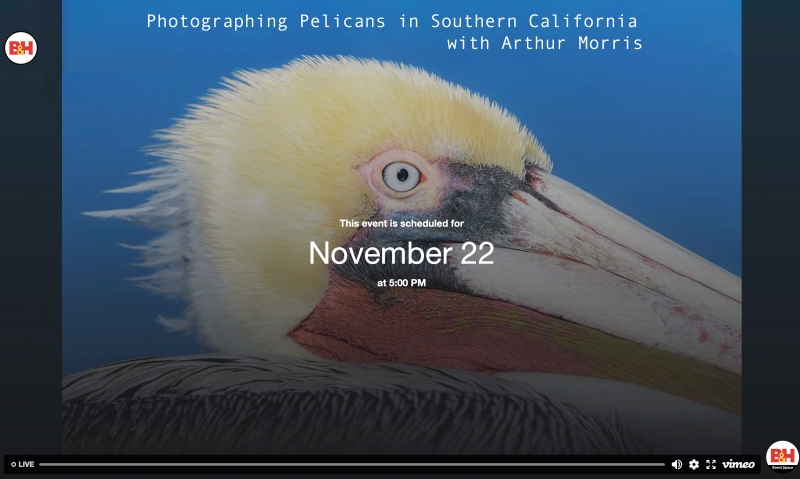
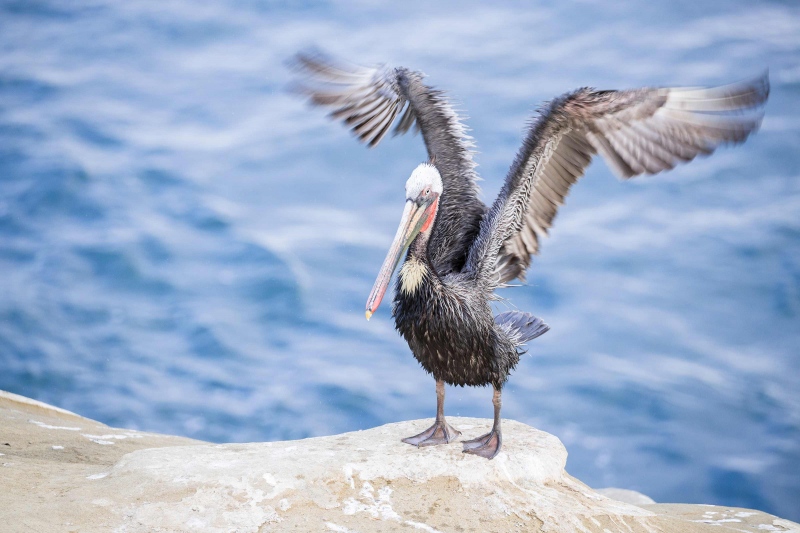
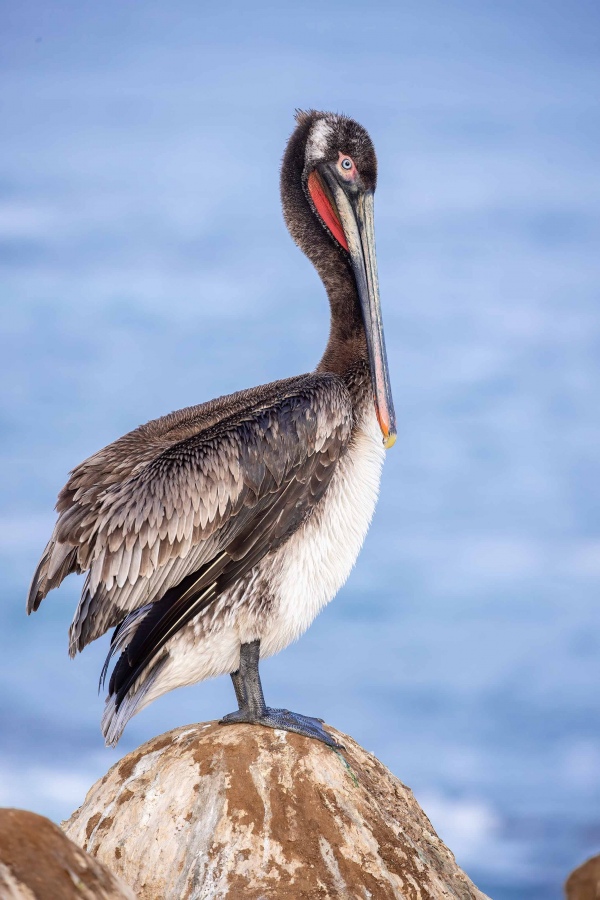
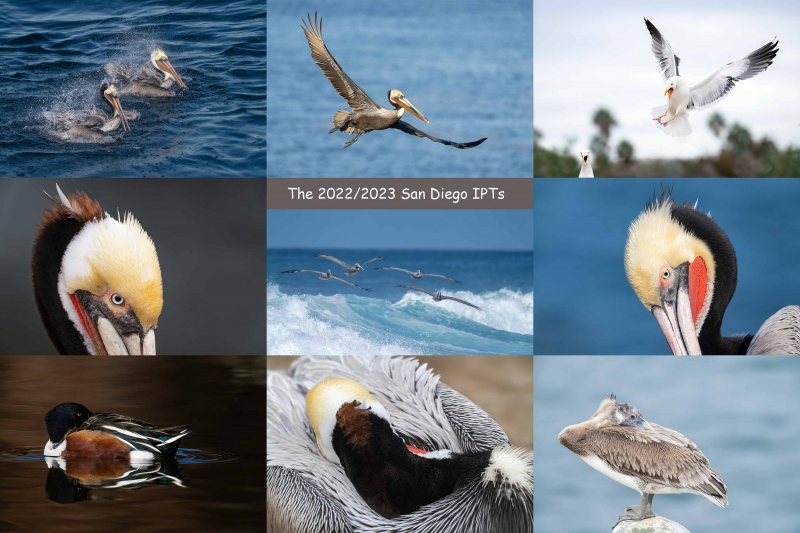
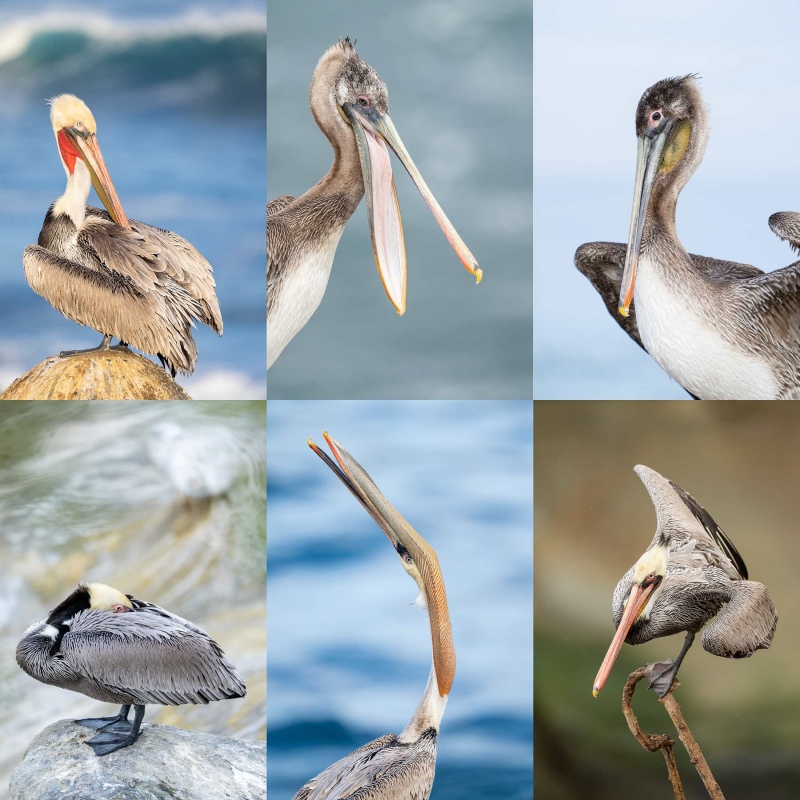
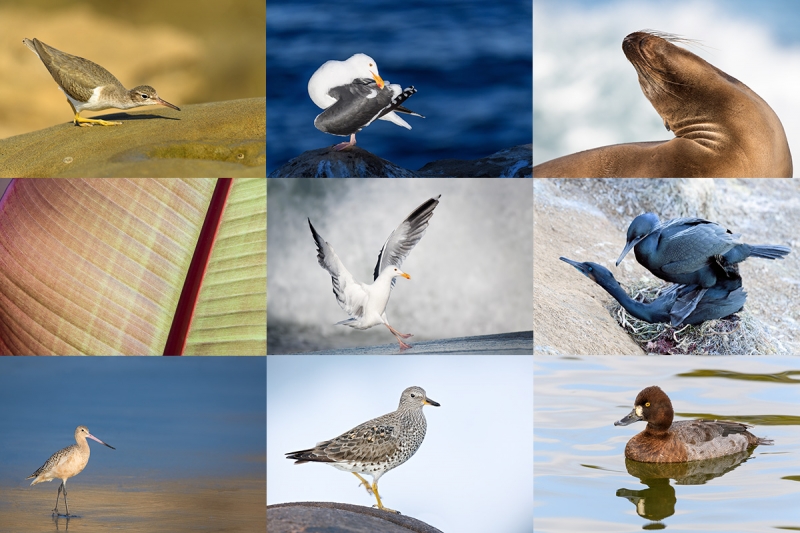

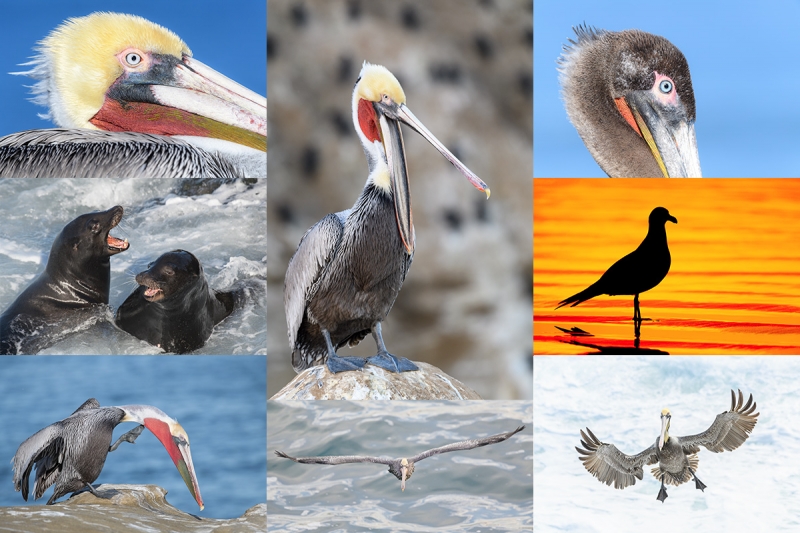














Both Brown Pelican photos are nice and interesting!! And Brown Pelican –bedraggled, flapping likely after bathing — is “Splish Splash I was taking a bath”!!
He was!
a
Ahhh. 1Dx II was/is a great body…albeit with a machine gun shutter sound! Thank goodness for mirrorless.
In a lot more ways than one!
a